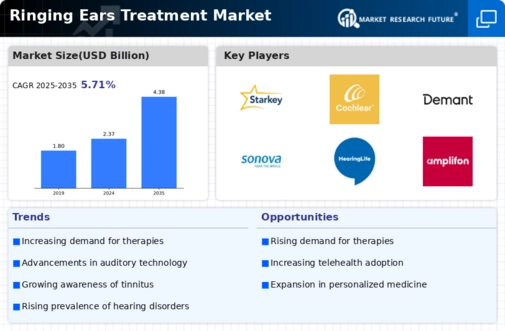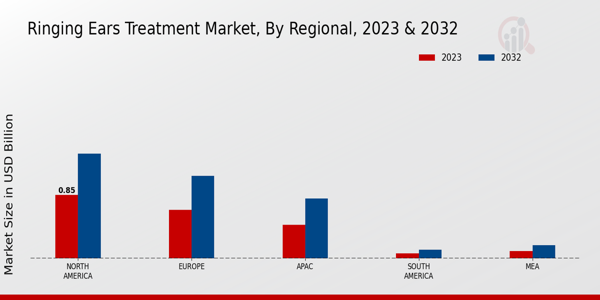Market Growth Projections
The Global Ringing Ears Treatment Market Industry is poised for substantial growth, with projections indicating an increase from 2.37 USD Billion in 2024 to 4.38 USD Billion by 2035. This growth trajectory reflects a compound annual growth rate of 5.73% from 2025 to 2035, driven by various factors such as technological advancements, rising healthcare expenditure, and increasing awareness of tinnitus. The market's expansion is expected to be supported by ongoing research and development efforts aimed at discovering innovative treatment options that cater to the diverse needs of patients suffering from ringing ears.
Rising Healthcare Expenditure
An upward trend in global healthcare expenditure is significantly impacting the Global Ringing Ears Treatment Market Industry. As countries allocate more resources to healthcare, there is an increased focus on specialized treatments for conditions like tinnitus. This financial commitment enables the development and accessibility of advanced treatment options, fostering a more robust market environment. The anticipated compound annual growth rate of 5.73% from 2025 to 2035 underscores the potential for sustained growth in this sector. Enhanced funding for healthcare initiatives may also facilitate research into innovative therapies, further expanding treatment options for patients.
Regulatory Support and Approvals
Regulatory support plays a pivotal role in the Global Ringing Ears Treatment Market Industry by facilitating the approval of new treatment options. Governments and health authorities are increasingly recognizing the need for effective tinnitus management solutions, leading to streamlined approval processes for innovative therapies. This regulatory environment encourages pharmaceutical companies and researchers to invest in the development of new treatments. As a result, the market is likely to see an influx of novel therapies that can address the diverse needs of tinnitus patients, contributing to overall market growth.
Advancements in Treatment Technologies
Technological innovations are playing a crucial role in shaping the Global Ringing Ears Treatment Market Industry. New treatment modalities, such as sound therapy and neuromodulation techniques, are emerging, offering patients more effective options for managing tinnitus. These advancements not only enhance patient outcomes but also attract investment in research and development. As the industry evolves, the introduction of novel therapies is expected to contribute to the market's expansion, with projections indicating a growth to 4.38 USD Billion by 2035. The integration of technology into treatment protocols may also improve patient adherence and satisfaction.
Increasing Prevalence of Hearing Disorders
The Global Ringing Ears Treatment Market Industry is witnessing a surge in demand due to the rising prevalence of hearing disorders, including tinnitus. As populations age, the incidence of these conditions increases, prompting a greater need for effective treatments. In 2024, the market is projected to reach 2.37 USD Billion, reflecting the growing awareness and diagnosis of hearing-related issues. This trend is particularly evident in developed regions where healthcare access is more prevalent, leading to higher treatment rates. The increasing number of patients seeking relief from tinnitus symptoms is likely to drive market growth significantly.
Growing Awareness and Education Initiatives
The Global Ringing Ears Treatment Market Industry benefits from increasing awareness and education initiatives aimed at both healthcare professionals and the general public. Campaigns designed to inform individuals about the causes and treatment options for tinnitus are crucial in reducing stigma and encouraging those affected to seek help. As awareness grows, more patients are likely to pursue treatment, thereby driving market growth. This trend is supported by various health organizations that emphasize the importance of early intervention, which could lead to a more substantial market presence in the coming years.












